
Tibetan Buddhism is a form of Buddhism practiced in Tibet, Bhutan and Mongolia. It also has a sizable number of adherents in the areas surrounding the Himalayas, including the Indian regions of Ladakh, Sikkim, and Arunachal Pradesh, as well as in Nepal. Smaller groups of practitioners can be found in Central Asia, Xinjiang, Inner Mongolia, and some regions of Russia, such as Tuva, Buryatia, and Kalmykia.

Vajrayāna, also known as Mantrayāna, Mantranāya, Guhyamantrayāna, Tantrayāna, Tantric Buddhism, and Esoteric Buddhism, is a Buddhist tradition of tantric practice that developed in the Indian subcontinent and spread to Tibet, Nepal, other Himalayan states, East Asia, and Mongolia.

The Kagyu school, also transliterated as Kagyü, or Kagyud, which translates to "Oral Lineage" or "Whispered Transmission" school, is one of the main schools of Tibetan Buddhism. The Kagyu lineages trace themselves back to the 11th century Indian Mahasiddhas Naropa, Maitripa and the yogini Niguma, via their student Marpa Lotsawa (1012–1097), who brought their teachings to Tibet. Marpa's student Milarepa was also an influential poet and teacher.

Mahāmudrā literally means "great seal" or "great imprint" and refers to the fact that "all phenomena inevitably are stamped by the fact of wisdom and emptiness inseparable". Mahāmudrā is a multivalent term of great importance in later Indian Buddhism and Tibetan Buddhism which "also occurs occasionally in Hindu and East Asian Buddhist esotericism."

Marpa Lotsāwa, sometimes known fully as Marpa Chökyi Lodrö or commonly as Marpa the Translator, was a Tibetan Buddhist teacher credited with the transmission of many Vajrayana teachings from India, including the teachings and lineages of Mahamudra. Due to this the Kagyu lineage, which he founded, is often called Marpa Kagyu in his honour.

Drikung Kagyü or Drigung Kagyü is one of the eight "minor" lineages of the Kagyu school of Tibetan Buddhism. "Major" here refers to those Kagyü lineages founded by the immediate disciples of Gampopa (1079-1153), while "minor" refers to all the lineages founded by disciples of Gampopa's main disciple, Phagmo Drupa (1110-1170). One of these disciples, Jigten Sumgön (1143-1217), is the founder of Drikung.
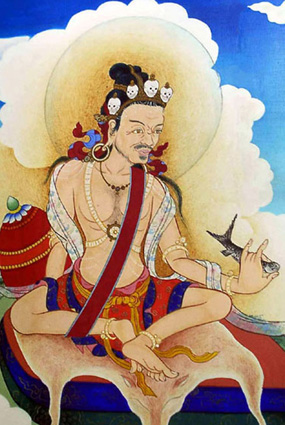
Tilopa was an Indian Buddhist monk in the tantric Kagyu lineage of Tibetan Buddhism.

Nāropā or Abhayakirti was an Indian Buddhist Mahasiddha. He was the disciple of Tilopa and brother, or some sources say partner and pupil, of Niguma. As an Indian Mahasiddha, Naropa's instructions inform Vajrayana, particularly his six yogas of Naropa relevant to the completion stage of anuttarayogatantra. He was also one of the gatekeepers of Vikramashila monastery which is located in Bihar.

The Six Dharmas of Nāropa are a set of advanced Tibetan Buddhist tantric practices compiled by the Indian mahasiddhas Tilopa and Nāropa and passed on to the Tibetan translator-yogi Marpa Lotsawa.

The Shangpa Kagyu is known as the "secret lineage" of the Kagyu school of Vajrayana or Tibetan Buddhism and differs in origin from the better known Dagpo Kagyu schools. The Dagpo Kagyu are the lineage of Tilopa through his student Naropa, often traced through Naropa's famous student Marpa Lotsawa and thus called "Marpa Kagyu", while the Shangpa lineage descends from Tilopa's student Niguma, who was Naropa's sister, as well as from the teachings of Sukhasiddhi. Its founder was Khyungpo Naljor, the student of both women, whose monastery in the Shang Valley gave its name to the tradition.
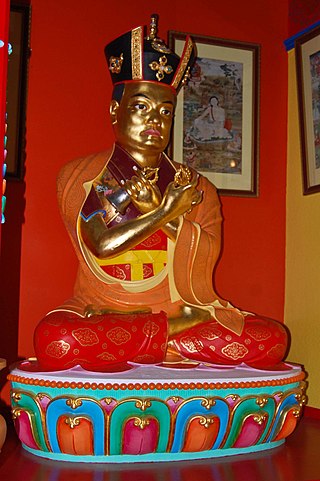
Karma Kagyu, or Kamtsang Kagyu, is a widely practiced and probably the second-largest lineage within the Kagyu school, one of the four major schools of Tibetan Buddhism. The lineage has long-standing monasteries in Tibet, China, Russia, Mongolia, India, Nepal and Bhutan, with current centres in over 60 countries. The spiritual head of the Karma Kagyu is the Gyalwa Karmapa; the 2nd among the 10 Karmapas had been the principal spiritual advisors to successive emperors of China. The Karma Kagyu are sometimes called the "Black Hat" lamas, in reference to the Black Crown worn by the Karmapa.
In Tibetan Buddhism, Ngöndro refers to the preliminary, preparatory or foundational practices or disciplines common to all four schools of Tibetan Buddhism and also to Bon. They precede deity yoga.

Vajrayoginī is an important figure in Buddhism, especially revered in Tibetan Buddhism. In Vajrayana she is considered a female Buddha and a ḍākiṇī. Vajrayoginī is often described with the epithet sarvabuddhaḍākiṇī, meaning "the ḍākiṇī [who is the Essence] of all Buddhas". She is an Anuttarayoga Tantra meditational deity (iṣṭadevatā) and her practice includes methods for preventing ordinary death, intermediate state (bardo) and rebirth (samsara) by transforming them into paths to enlightenment, and for transforming all mundane daily experiences into higher spiritual paths.
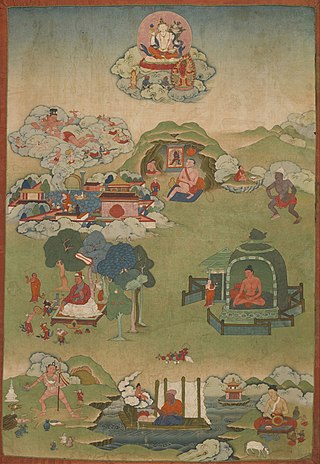
Tibetan tantric practice, also known as "the practice of secret mantra", and "tantric techniques", refers to the main tantric practices in Tibetan Buddhism. The great Rime scholar Jamgön Kongtrül refers to this as "the Process of Meditation in the Indestructible Way of Secret Mantra" and also as "the way of mantra," "way of method" and "the secret way" in his Treasury of Knowledge. These Vajrayāna Buddhist practices are mainly drawn from the Buddhist tantras and are generally not found in "common" Mahayana. These practices are seen by Tibetan Buddhists as the fastest and most powerful path to Buddhahood.
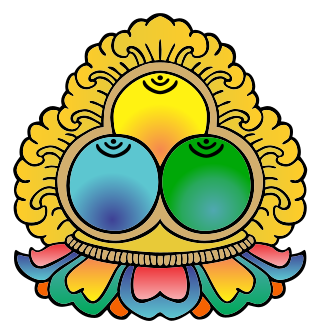
In Tibetan Buddhism, the Three Jewels and Three Roots are supports in which a Buddhist takes refuge by means of a prayer or recitation at the beginning of the day or of a practice session. The Three Jewels are the first and the Three Roots are the second set of three Tibetan Buddhist refuge formulations, the Outer, Inner and Secret forms of the Three Jewels. The 'Outer' form is the 'Triple Gem', the 'Inner' is the Three Roots and the 'Secret' form is the 'Three Bodies' or trikāya of a Buddha.

Dream yoga or milam —the Yoga of the Dream State—is a suite of advanced tantric sadhana of the entwined Mantrayana lineages of Dzogchen. Dream yoga consists of tantric processes and techniques within the trance Bardos of Dream and Sleep Six Dharmas of Naropa. In the tradition of the tantra, the dream yoga method is usually passed on by a qualified teacher to his/her students after necessary initiation. Various Tibetan lamas are unanimous that it is more of a passing of an enlightened experience rather than any textual information.

Thangtong Gyalpo, also known as Chakzampa, the "Iron Bridge Maker", Tsöndrü Zangpo "Excellent Persistence", and the King of the Empty Plain. He was also known by a variation of this name, Madman of the Empty Valley. He was a great Buddhist adept, a Chöd master, yogi, physician, blacksmith, architect, and a pioneering civil engineer. He is considered a mind emanation of Padmasambhava and a reincarnation of Dolpopa Sherab Gyaltsen. He founded the Iron Chain lineage of the Shangpa Kagyu school of Tibetan Buddhism, and he recognized the first Samding Dorje Phagmo, Chökyi Drönma (1422–1455), the female incarnation lineage of Vajravārāhī.
Sarah Elizabeth Harding is a qualified lama and teacher in the Shangpa Kagyu tradition of Tibetan Buddhism. Since 1972, she has been a student and translator of Kalu Rinpoche (1905-1989). She is the daughter of award-winning American screenwriter and playwright Isobel Lennart.
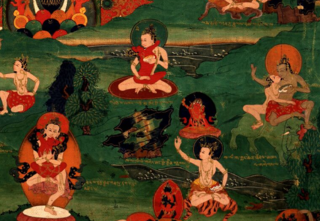
Karmamudrā is a Vajrayana Buddhist technique which makes use of sexual union with a physical or visualized consort as well as the practice of inner heat (tummo) to achieve a non-dual state of bliss and insight into emptiness. In Tibetan Buddhism, proficiency in inner heat yoga is generally seen as a prerequisite to the practice of karmamudrā.
Sukhasiddhi was an Indian teacher of Vajrayana Buddhism, a yogini and master of meditation. She was born in west Kashmir to a large, poor family. A mother of three sons and three daughters, she once gave a beggar the only food in the house and was expelled from home.

















